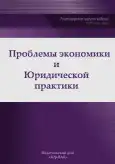Digital image of a citizen: analysis of the conceptual and categorical apparatus
- Authors: Sannikov D.V.1
-
Affiliations:
- Perm State University
- Issue: Vol 19, No 5 (2023)
- Pages: 80-85
- Section: Private Law (Civil) Sciences
- URL: https://journals.eco-vector.com/2541-8025/article/view/626943
- EDN: https://elibrary.ru/YZLAEE
- ID: 626943
Cite item
Abstract
It is stated that the evolution of the concept of the right to a digital image is a kind of private law response to the technological challenge associated with the digital transformation of a citizen's private life. In the conditions of total digitalization, it becomes more difficult for a citizen to keep secret information related to his private life, including personal data, which acquire new (digital) forms of expression.
The purpose of the study. The article discusses the basics of the civilistic doctrine of the personal image, the information image and the digital image of a citizen. The purpose of the study is to analyze the Russian civil doctrine about the digital image of a citizen.
Conclusions. The research resulted in the following original conclusions: the digital image of a citizen is part of an informational image, which in turn is a structural element of a personal image. In addition, the author's definition of the «digital image of a citizen» is given in the article—it is an intangible benefit obtained as a result of the realization of the right to privacy, including a digital footprint and a digital shadow consisting of identification, secret and communication information.
Full Text
About the authors
Denis V. Sannikov
Perm State University
Author for correspondence.
Email: i@sannikov-7.ru
lawyer in the lawyer's office, Candidate of the degree of Candidate of Legal Sciences of the Department of Business Law, Civil and Arbitration Process
Russian Federation, PermReferences
- Anisimova A.S. The mechanism of legal regulation of Internet relations: problems of theory and practice: dis. ... cand. jurid. sciences'. Saratov, 2019. 222 p.
- Ayusheeva I.Z. The exercise of personal non-property rights in the creation of bioprinted human organs // Lex russica. 2020. No. 7. pp. 24–33.
- Bogdanov E.V. Information as an object of civil legal relations // Civil law. 2018. No. 5. pp. 29–33.
- Bogdanov D.E. Technodeterminism in private law: the impact of bioprinting on the development of the concept of protecting the right to a digital image // Bulletin of Perm University. Legal sciences. 2020. No. 4. pp. 678–704.
- Goloskokov L.V. Theory of network law / Edited by A.V. Malko. St. Petersburg: Law Center Press, 2006. 188 p.
- Gorbatov R.O., Romanov A.D. Creation of organs and tissues using bioprinting // Bulletin of the Volgograd State Medical University. 2017. No. 3(63). pp. 3–9.
- Zharova A.K. Problems of anonymity of subjects on the Internet // Proceedings of the Institute of State and Law of the Russian Academy of Sciences. 2009. No. 5. pp. 135–159.
- Kaveeva A.D., Gurin K.E. Artificial profiles of VKontakte and their impact on the social network of users // Journal of Sociology and Social Anthropology. 2018. Vol. XXI. No. 2. pp. 214–231.
- Kartskhiya A.A. Digital transformation of law // Monitoring of law enforcement. 2019. No. 1(30). pp. 25–29.
- Komissarova O.R. Social networks and inheritance of personal data: ethical and pragmatic aspects // Education and science in the modern world. Innovation. 2018. No. 1(14). pp. 21–26.
- Kuznetsova O.A. Economics-social nature and legal form of crowdfunding relations // Perm Legal Almanac. 2019. No. 2. pp. 473–483.
- Maleina M.N. The right of a student and teacher to an individual appearance // Lex russica. 2019. no. 3. pp. 24-33.
- Mironov V.A. Following the creator. Bioprinting technologies // Science at first hand. 2013. No. 4. pp. 14–25.
- Naumov V.B. On the formation of the institute of identification of subjects in the system of Russian information law // New challenges and threats to information security: legal problems: Collection of scientific papers / Ed. T.A. Polyakov, I.L. Bachilo, V.B. Naumov. M.: «Canon+» ROOI «Rehabilitation», 2016. pp. 151–152.
- Panarina M.M. Inheritance of an account in social networks and issues of digital inheritance: legal research // Inheritance law. 2018. No. 3. pp. 27–28.
- Puchkov V.O. The main problems of the digital image of the subject of civil law in the civil doctrine and judicial practice // Arbitration disputes. 2020. No. 3. pp. 143–158.
- Skvortsov A. Fake accounts: erat, est, fuit? // Intellectual property. Copyright and related rights. 2015. No. 2. pp. 25–34.
- Talapina E.V. Law and digitalization: new challenges and prospects // Journal of Russian Law. 2018. No. 2. pp. 5–17.
- Hesuani Yu.J., Sergeeva N.S., Mironov V.A., Mustafin A.G., Kaprin A.D. Introduction to 3D bioprinting: the history of the formation of the direction, principles and stages of bioprinting // Genes and Cells. 2018. No. 3. pp. 38–45.
- Shebanova N.A. The modern appearance of the individual: is the choice free? // Proceedings of the Institute of State and Law of the Russian Academy of Sciences. 2017. No. 4(62). pp. 176–196.
- Benatti F. Danno all'immagine, Digesto civile (Torino: UTET, 2011), VI. 275 p.
- Bergmann S. Publicity Rights in the United States and Germany: A Comparative Analysis // Loyola of Los Angeles Entertainment Law Journal. 1999. Vol. 19. Pp. 479–480.
- Logeais E. & Schroeder J.-B. The French Right of Image: An Ambiguous Concept Protecting the Human Persona // The Loyola of Los Angeles Entertainment Law Journal. 1998. Vol. 18. P. 551.
- Polito P. The Protection of Our Image: Between the Right to One's Own Image and the Right of Publicity // The Italian Law Journal. 2018. Special Issue. Pp. 69–81.
- Reiter E.H. Personality and Patrimony: Comparative Perspectives on the Right to One's Image (2001–2002) // Tulane Law Review. 2002. Vol. 76. Pp. 673–726.
Supplementary files








